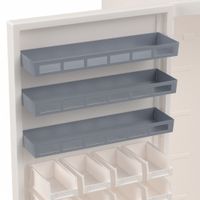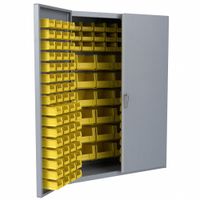Call +(254) 703 030 000 / 751 483 999 / 721 704 777
- Home
- Material Handling
- Storage Workspace
- Storage Cabinets
- Bin Cabinets Accessories
.....Read More
Frequently Asked Questions
What are the benefits of using bin cabinets for storage?
Bin cabinets offer several benefits for storage:
1. **Organization**: They provide a structured way to store items, making it easy to categorize and access them. This reduces clutter and enhances efficiency.
2. **Space Optimization**: Bin cabinets maximize vertical and horizontal space, allowing for more items to be stored in a compact area. This is particularly useful in small spaces.
3. **Protection**: They protect contents from dust, dirt, and damage, ensuring items remain in good condition. This is crucial for sensitive or valuable items.
4. **Accessibility**: With labeled bins and clear fronts, items are easy to locate and retrieve, saving time and effort.
5. **Versatility**: Bin cabinets come in various sizes and configurations, suitable for different storage needs, from small parts to larger tools.
6. **Durability**: Made from robust materials, they withstand heavy use and harsh environments, providing long-term storage solutions.
7. **Safety**: By keeping items off the floor and organized, bin cabinets reduce the risk of accidents and injuries in the workplace.
8. **Aesthetic Appeal**: They contribute to a tidy and professional appearance, which can enhance the overall look of a workspace.
9. **Cost-Effectiveness**: By improving organization and reducing damage to stored items, bin cabinets can lead to cost savings over time.
10. **Scalability**: They can be easily expanded or reconfigured to accommodate growing storage needs, offering flexibility for future changes.
How do I choose the right size bin cabinet for my needs?
1. **Assess Storage Needs**: Determine the types and quantities of items you need to store. Consider the size, weight, and frequency of access for each item.
2. **Space Availability**: Measure the available space where the bin cabinet will be placed. Consider height, width, and depth to ensure it fits comfortably without obstructing movement.
3. **Bin Size and Configuration**: Choose a cabinet with bins that match the size of your items. Look for adjustable or removable bins for flexibility. Consider the number of bins needed for current and future storage.
4. **Weight Capacity**: Ensure the cabinet can support the weight of stored items. Check the load capacity of both the cabinet and individual bins.
5. **Material and Durability**: Select a cabinet made from durable materials like steel or heavy-duty plastic, especially for industrial or heavy-use environments.
6. **Accessibility**: Consider how often you need to access the items. Opt for cabinets with easy-to-open doors or drawers and clear labeling options for quick identification.
7. **Security Features**: If necessary, choose a cabinet with locking mechanisms to secure valuable or sensitive items.
8. **Budget**: Determine your budget and find a cabinet that offers the best balance between cost and features.
9. **Future Expansion**: Consider potential future storage needs. Choose a cabinet that allows for easy expansion or reconfiguration.
10. **Aesthetic and Design**: If the cabinet is in a visible area, consider its appearance and how it fits with the surrounding decor.
11. **Vendor Reputation**: Purchase from reputable manufacturers or suppliers known for quality and customer service.
By considering these factors, you can select a bin cabinet that effectively meets your storage needs.
Can bin cabinets be customized with different bin sizes?
Yes, bin cabinets can be customized with different bin sizes. Customization allows for flexibility in organizing and storing various items, catering to specific needs and preferences. Manufacturers often offer modular designs where bins of different sizes can be interchanged or rearranged within the cabinet framework. This adaptability is beneficial for maximizing storage efficiency and ensuring that the cabinet can accommodate items of varying dimensions.
Customization options may include adjustable shelves, removable dividers, and a variety of bin sizes and shapes. Some systems allow for the addition of extra bins or the replacement of existing ones to better suit changing storage requirements. Materials and finishes can also be customized to match the aesthetic or functional needs of the space where the cabinet will be used.
In industrial or commercial settings, customized bin cabinets can enhance workflow by organizing tools, parts, or supplies in a manner that aligns with specific operational processes. In residential settings, they can be tailored to fit into particular spaces, such as garages, kitchens, or closets, providing a neat and organized appearance.
Overall, the ability to customize bin cabinets with different bin sizes offers significant advantages in terms of organization, efficiency, and adaptability, making them a versatile storage solution for various environments.
Are mobile bin cabinets as durable as stationary ones?
Mobile bin cabinets and stationary ones differ in design and intended use, which affects their durability. Mobile bin cabinets are designed for flexibility and movement, often featuring wheels or casters for easy transport. This mobility can introduce wear and tear, especially if the cabinets are frequently moved over rough surfaces or loaded heavily. The materials used in mobile cabinets are typically chosen to balance durability with weight, often resulting in lighter construction compared to stationary cabinets.
Stationary bin cabinets, on the other hand, are designed to remain in one place, allowing for a more robust construction. They can be made from heavier materials, such as thicker steel or wood, which can enhance their durability. The lack of movement reduces the risk of damage from transportation, making them potentially longer-lasting in environments where they are not subject to frequent relocation.
However, the durability of both types of cabinets also depends on factors such as the quality of materials, construction, and the environment in which they are used. High-quality mobile cabinets with reinforced frames and durable casters can be quite resilient, while poorly constructed stationary cabinets may not withstand heavy use.
In summary, while stationary bin cabinets generally offer greater durability due to their robust construction and lack of movement, high-quality mobile bin cabinets can also be durable if designed and used appropriately. The choice between the two should consider the specific needs of the environment, including the necessity for mobility and the expected load and usage conditions.
How do I maintain and clean bin cabinets?
1. **Regular Inspection**: Frequently check bin cabinets for any signs of damage, wear, or contamination. This helps in identifying issues early.
2. **Empty and Sort**: Remove all items from the bins. Sort and discard expired or unnecessary items to prevent clutter and contamination.
3. **Dusting**: Use a microfiber cloth or duster to remove dust from the cabinet surfaces, including shelves and corners.
4. **Cleaning Solution**: Prepare a mild cleaning solution using water and a gentle detergent. Avoid harsh chemicals that might damage the cabinet material.
5. **Wipe Down**: Use a soft cloth or sponge dipped in the cleaning solution to wipe down the interior and exterior surfaces of the cabinet. Pay attention to handles and frequently touched areas.
6. **Rinse and Dry**: Rinse the cloth with clean water and wipe the surfaces again to remove any soap residue. Dry thoroughly with a clean towel to prevent moisture buildup.
7. **Disinfect**: Apply a disinfectant spray or wipes to high-touch areas to kill germs and bacteria. Ensure the disinfectant is suitable for the cabinet material.
8. **Organize**: Return items to the bins, organizing them for easy access. Label bins if necessary to maintain order.
9. **Lubricate Hinges**: Apply a small amount of lubricant to the cabinet hinges to ensure smooth operation and prevent squeaking.
10. **Check for Pests**: Look for signs of pests and take preventive measures if necessary, such as using pest repellents or traps.
11. **Regular Maintenance Schedule**: Establish a routine cleaning and maintenance schedule to keep the bin cabinets in optimal condition.
What materials are bin cabinets typically made from?
Bin cabinets are typically made from a variety of materials, each chosen for its specific properties and suitability for different environments and uses. Common materials include:
1. **Steel**: Often used for its strength and durability, steel bin cabinets are ideal for industrial settings where they may be subject to heavy use and need to support significant weight. They are often powder-coated to resist corrosion and wear.
2. **Stainless Steel**: This material is used in environments where hygiene is crucial, such as in medical or food service industries. Stainless steel is resistant to rust and easy to clean, making it suitable for sterile environments.
3. **Aluminum**: Lightweight and resistant to corrosion, aluminum bin cabinets are often used in environments where mobility is important. They are less durable than steel but offer a good balance of strength and weight.
4. **Plastic**: High-density polyethylene (HDPE) or polypropylene are common plastics used for bin cabinets. These materials are lightweight, resistant to chemicals, and suitable for environments where moisture is a concern. They are often used in laboratories or for storing chemicals.
5. **Wood**: Less common for industrial use, wood bin cabinets are often found in residential or office settings. They offer aesthetic appeal and can be made from various types of wood, including plywood or MDF, often with a laminate finish for added durability.
6. **Composite Materials**: These are engineered materials made from two or more constituent materials with different physical or chemical properties. They are designed to achieve a balance of strength, weight, and resistance to environmental factors.
Each material offers distinct advantages, and the choice depends on factors such as the intended use, environmental conditions, and budget.
Where can I purchase high-quality bin cabinets?
You can purchase high-quality bin cabinets from the following sources:
1. **Specialty Storage Retailers**: Companies like Uline, Grainger, and Global Industrial offer a wide range of industrial-grade bin cabinets designed for durability and heavy use. These retailers often provide detailed product specifications and customer reviews to help you make an informed decision.
2. **Home Improvement Stores**: Chains such as Home Depot and Lowe's carry a variety of bin cabinets suitable for both residential and commercial use. They offer both in-store and online shopping options, with the possibility of home delivery or in-store pickup.
3. **Office Supply Stores**: Staples and Office Depot offer bin cabinets that are ideal for office environments. These stores often have sales and promotions, which can make purchasing more cost-effective.
4. **Online Marketplaces**: Websites like Amazon and eBay provide a vast selection of bin cabinets from various sellers. You can compare prices, read customer reviews, and check ratings to ensure quality. Be sure to verify the seller's reputation and return policy.
5. **Direct from Manufacturers**: Companies like Akro-Mils and Durham Manufacturing sell directly to consumers through their websites. Purchasing directly from manufacturers can sometimes offer better pricing and customization options.
6. **Local Furniture Stores**: Some local furniture or specialty storage stores may carry high-quality bin cabinets. Visiting these stores allows you to see the product in person before purchasing.
7. **Custom Cabinet Makers**: For a more tailored solution, consider hiring a custom cabinet maker. This option allows you to specify materials, dimensions, and design features to meet your exact needs.
8. **Second-Hand Stores**: For budget-friendly options, check out second-hand stores or online platforms like Craigslist or Facebook Marketplace, where you might find gently used high-quality bin cabinets.


